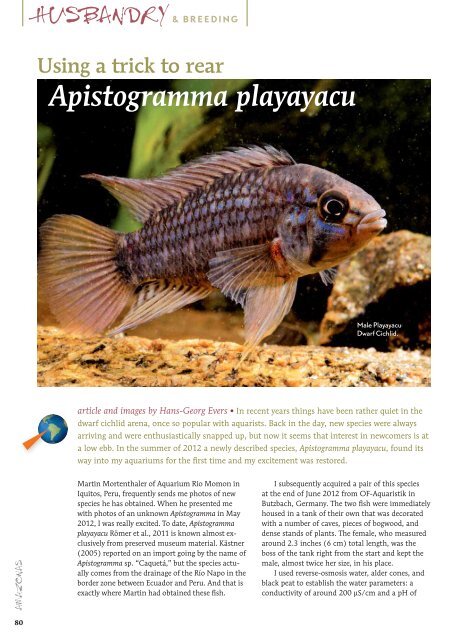Congo Killies - PageSuite
Congo Killies - PageSuite
Congo Killies - PageSuite
Create successful ePaper yourself
Turn your PDF publications into a flip-book with our unique Google optimized e-Paper software.
HUSBANDRY<br />
& BREEDING<br />
Using a trick to rear<br />
Apistogramma playayacu<br />
Male Playayacu<br />
Dwarf Cichlid.<br />
article and images by Hans-Georg Evers In recent years things have been rather quiet in the<br />
dwarf cichlid arena, once so popular with aquarists. Back in the day, new species were always<br />
arriving and were enthusiastically snapped up, but now it seems that interest in newcomers is at<br />
a low ebb. In the summer of 2012 a newly described species, Apistogramma playayacu, found its<br />
way into my aquariums for the first time and my excitement was restored.<br />
AMAZONAS<br />
Martin Mortenthaler of Aquarium Rio Momon in<br />
Iquitos, Peru, frequently sends me photos of new<br />
species he has obtained. When he presented me<br />
with photos of an unknown Apistogramma in May<br />
2012, I was really excited. To date, Apistogramma<br />
playayacu Römer et al., 2011 is known almost exclusively<br />
from preserved museum material. Kästner<br />
(2005) reported on an import going by the name of<br />
Apistogramma sp. “Caquetá,” but the species actually<br />
comes from the drainage of the Río Napo in the<br />
border zone between Ecuador and Peru. And that is<br />
exactly where Martin had obtained these fish.<br />
I subsequently acquired a pair of this species<br />
at the end of June 2012 from OF-Aquaristik in<br />
Butzbach, Germany. The two fish were immediately<br />
housed in a tank of their own that was decorated<br />
with a number of caves, pieces of bogwood, and<br />
dense stands of plants. The female, who measured<br />
around 2.3 inches (6 cm) total length, was the<br />
boss of the tank right from the start and kept the<br />
male, almost twice her size, in his place.<br />
I used reverse-osmosis water, alder cones, and<br />
black peat to establish the water parameters: a<br />
conductivity of around 200 μS/cm and a pH of<br />
80

















